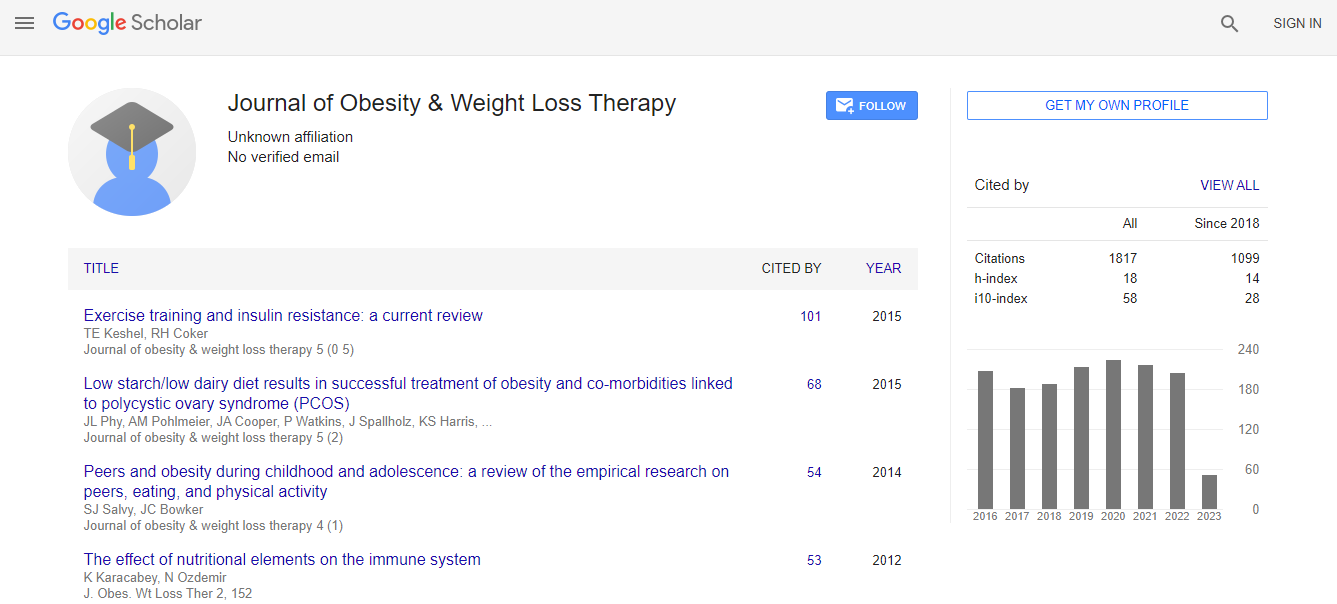Our Group organises 3000+ Global Conferenceseries Events every year across USA, Europe & Asia with support from 1000 more scientific Societies and Publishes 700+ Open Access Journals which contains over 50000 eminent personalities, reputed scientists as editorial board members.
Open Access Journals gaining more Readers and Citations
700 Journals and 15,000,000 Readers Each Journal is getting 25,000+ Readers
Google Scholar citation report
Citations : 2305
Journal of Obesity & Weight Loss Therapy received 2305 citations as per Google Scholar report
Journal of Obesity & Weight Loss Therapy peer review process verified at publons
Indexed In
- Index Copernicus
- Google Scholar
- Open J Gate
- Genamics JournalSeek
- Centre for Agriculture and Biosciences International (CABI)
- RefSeek
- Hamdard University
- EBSCO A-Z
- OCLC- WorldCat
- SWB online catalog
- CABI full text
- Cab direct
- Publons
- Geneva Foundation for Medical Education and Research
- Euro Pub
- University of Bristol
- Pubmed
- ICMJE
Useful Links
Recommended Journals
Related Subjects
Share This Page
Genotoxic Susceptibility among the People of different Prakriti groups having Type 2 Diabetes Mellitus
Joint Event on 12th International Conferences on Childhood Obesity and Nutrition & 3rd World Congress on Diabetes and Obesity
Saheli Banerjee
Jadavpur University, India
Posters & Accepted Abstracts: J Obes Weight Loss Ther
Abstract
Statement of Problem: The increasing occurrence of multi-organ affecting type 2 diabetes mellitus now becomes a serious threat to public health. Ayurveda classifies human population as combination of three Doshas- Vata, Pitta, and Kapha according to their basic constitution known as “Prakriti”. The Tridhoshas work in harmony to maintain good health in an individual. Any alteration of an individual’s homeostatic state of Dosha’s can lead to various diseases. Elevation of the doshas beyond an individual’s threshold causes specific doshic disorder. The study has been designed to investigate the clinical, anthropological and induced-genotoxic variation among the Prakriti groups having type 2 diabetes mellitus.Methodology & Theoretical orientation: This study was conducted with total sixty participants (age 30-70 years), ten in each Prakriti groups having type-2 diabetes mellitus with control. The selection was conducted as per the standard Prakriti assessment chart. The differences in biochemical parameters, DNA content and damage, apoptosis, ROS generation, interaction of DNA with heavy metals were observed. GraphPad Prism 8 was used to analyze the data; p < 0.01 was considered statistically significant.
Findings: Biochemical analysis suggested that people of Kapha is most susceptible to the renal and hepatic disorders. Whereas, significant decrease in DNA content (p <0.05), higher percentage of DNA damages were observed in Vata Prakriti (p <0.01) people having diabetes. The total cell damage and yield of ROS was also significantly higher in Vata Prakriti (p <0.0001) in comparison to other. The Vata and Kapha Prakriti were more prone to lead (II) and Vata and Pitta Prakriti were genetically more susceptible to arsenic metals.
Conclusions & Significance: The results indicate that people of Vata Prakriti are the most genetically susceptible group in comparison to others. These could help in creating personalized treatment of diabetes among individual Prakriti. A worldwide assessment is needed for better applicability.
Biography

 Spanish
Spanish  Chinese
Chinese  Russian
Russian  German
German  French
French  Japanese
Japanese  Portuguese
Portuguese  Hindi
Hindi 
